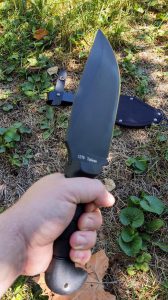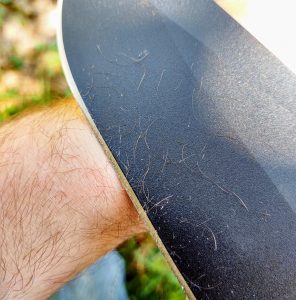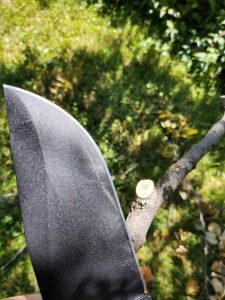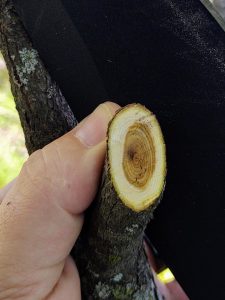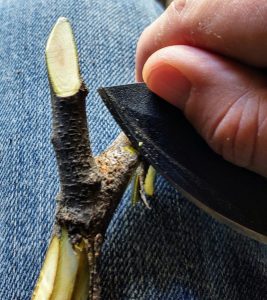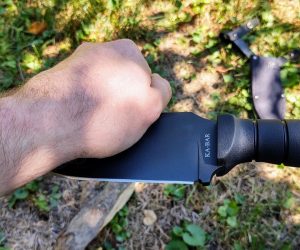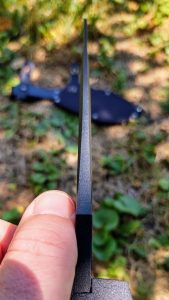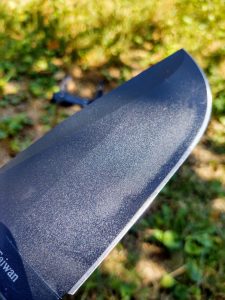Some situations call for a small knife and then there are situations that call for a big knife. And today I am going to be getting my hands on a big knife.
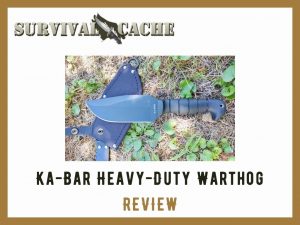
For this review, I will be testing out the Kabar Heavy-Duty Warthog. I have been eyeballing this model for quite some time and finally decided to get it.
I hate to be the one to give the ending away, but boy am I glad I got it. So, grab a snack and a drink because I have a lot to say about the Kabar Warthog in this review. To start, let’s take a look at what the knife has to offer.
SKIP AHEAD
KaBar Heavy Duty Warthog Review
Dimensions and Blade Length
This is a good place to start because of its size. The blade is 6.75 inches long, 2.438 inches wide, and 0.25 inches thick. The overall length from the tip to the pommel is 12.25 inches. All of this weighs in at 1.05lb.
Blade Material
The blade is made from SK5 with a Rockwell hardness of 52-54.
Blade Type
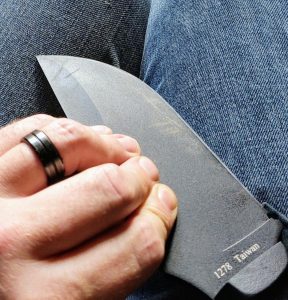
This model is a fixed blade knife with a flat grind on the cutting edge and is a full tang. The blade also features a black coating that protects the underlying metal while reducing glare.
Sheath
Comes with a leather/Cordura sheath.
Handle
It has a TPR handle with a small lanyard hole
Color
The knife, handle and the sheath all come in black.
Country of Origin
Unlike a lot of products that are made in China or even Mexico, the Warthog is made in Taiwan. The manufacturer of Ka bar knives has been around since World War II.
Kabar Warthog Field Test Review
As soon as I opened the box I was surprised by the size of this knife. I mean I knew it was going to be big, but wow, it was larger than I expected. I held the knife out and found it to be well balanced to my liking. I was able to balance the knife on one finger with it being just a tad heavy on the handle side.
I grabbed the handle and turned it over a few times and it felt really good in my hand. So good that I had to get outside and try it out.
This Kabar Knife is Razor Sharp
Of course, one of the first things I want to know about any cutting tool is how sharp it is right out of the box. Nobody likes having to sharpen a brand new knife.
Dry Shave Test
To see how sharp it was, I decided to do the dry shave test on my forearm. While I am old school in most of my ways, I do not recommend this method to anyone. Having said that, the belly of the knife was able to easily shave off a small pile of hair. Given the size of this knife, I was surprised that it was this sharp.
Disclaimer: Don’t test your knives this way.
Thin Curls
The next test I wanted to try was to cut thin slices of wood for a fire. Again, because of the size of the knife, I wasn’t sure how well it was going to do this. But that was before the shaving test.
I grabbed a thick piece of wood and pushed the blade over the surface of the bark.
The cutting edge slid smoothly through it and I was able to make some very thin curls of bark. I was impressed with how easily and smoothly it did this. From here, I decided to make a feather stick because everyone loves making feather sticks.
The Ka Bar Knife’s Chopping Ability
Alright, on to something a little more heavy duty.
Generally speaking, I do not use my knives for chopping tasks, but something about the Warthog was begging for me to use it in this manner.
I took the same chunk of wood as before and stood it upright. I took one good swing and the blade bit into the wood very well and deeply. I did this over and over and with each swing, the knife found its mark, tossing chunks of wood to the side.
The large handle and weight behind the knife made this task very comfortable to carry out.
“Machete-Style” Chopping
When I was doing the first chopping test the knife was very comfortable while I was swinging it. Because of this, I wanted to try using it more like a machete.
I found a branch laying on the ground and wanted to see how it would work processing it into smaller pieces. I stood the branch up and with one hand began swinging the knife.
With its razor-sharp edge and the weight behind it, the blade passed through almost everything I aimed at in one go.
I could understand this on the smaller branches, but some were as thick or thicker than my thumb. And even with those, it had no problem. Needless to say, I cut this branch up rather quickly.
Although it doesn’t give the reach of a machete, I think that this knife would work quite well for clearing a path.
Detail Work
Since the Warthog is pretty much a straight-edge knife with a very large belly, the tip of the knife isn’t going to be able to do extreme detail work. But because the knife is so large, I was able to choke my hold up towards the tip of the knife to have better control while working in small areas.
Speaking of detail work, I was curious how thin of a point I could make on a piece of wood. Usually, with large knives, it can be difficult to create a thin, fine point on the end of a stick. There are many tasks that a fine pointed piece of wood can come in handy for, so I was pleased that the knife had no problem doing this, unlike some knives.
Drawknife and Scrapper
Have I already hinted at the largeness of this knife? Because it’s big. I only bring it up yet again, because there are two other ways in which I like to use a knife that the size of the Warthog lends itself to. And that is as a drawknife and as a scrapper.
Because of the large handle and the width of the blade, it is very comfortable using two hands to use this as a drawknife or as a scrapper. The front portion of the belly lends itself particularly well as a scrapper.
Handle
The handle is hard, yet has a slightly rubberized feel to it with five circular cutouts that aid with grip.
The top portion of the handle – the side that lines up with the spine of the blade – is relatively straight and flat, while the rest of the handle is round. For me, this makes the knife extremely comfortable to hold whether using a forward or reverse grip.
At the butt of the handle, there is a deep downward curve, that depending on my grip, catches my pinky or index finger. This helps to prevent the knife from slipping out of my hand during operation.
Moving towards the blade, the handle flares out slightly on both sides. This provides a very small handguard to also help reduce slipping. Where the knife spine meets the handle, there is a curved upswing to the spine. I found this to be an extremely comfortable spot for resting my thumb.
The last thing to note about the handle is the lanyard hole. It is about the same diameter as a piece of paracord which is nice because I will most likely be adding a looped piece of paracord to this knife soon.
Keeping It Covered
A quick rundown of the sheath. It opens on the top and from the side to allow for the shape of the knife. There is one large belt loop for carrying and two snap straps for securing the knife. One towards the top of the handle and one that goes across the spine of the blade.
There is also a small ring on the bottom, serving as an extra anchor point for securing it all down.
The sheath is the only thing about the Warthog I am on the fence about. While that could change with time, I doubt it. Here are the reasons I am not a fan of it:
First off, I wish the whole thing would have been made out of one kind of material, specifically leather. The back is made of leather and the front is made of Cordura with a soft spacer in between the two materials.
Secondly, I found two stitches already coming out around one of the rivets.
While this isn’t indicative of the overall quality control, I am not too thrilled about it.
Thirdly, the loop on the bottom of it is plastic and feels extremely flimsy.
The last thing that I am going to point out is the placement of the rivets and the back of the snaps as it relates to where the knife is inserted into the sheath.
Unless extreme care is taken every single time the knife is pulled out and placed back in, the knife is going to come into contact with the hardware. Over time, I see this possibly dulling the cutting edge and scrapping away the coating on the blade. To prevent this, I will simply be covering the hardware on the inside with a piece of duct tape.
KaBar Heavy Duty Warthog Pros and Cons
Pros
- A lot of knife for the price!
- Great balance.
- Completes some detail work decently.
- Is comfortable as a draw blade or as a scraper.
- Chops extremely well.
- Switching between different grips is quick and easy.
- The black coating on the blade will reduce glare and help to protect the underlying metal.
Cons
- The biggest downfall of this knife isn’t the knife, but the sheath.
- Given the shape and length of the handle, I can see it not being comfortable for everyone.
- The black coating on the blade is not friendly for food preparation.
Verdict
I had a good feeling that I was going to like this knife, as I inevitably do with most knives by Ka Bar, but that may be bordering on love at this point. The Warthog just feels right when it is in my hand, and it certainly gives the impression of a no-nonsense knife ready for work.
One reason I ended up liking this knife more than I thought was because of the price. It is very affordable when considering how much knife comes in this package. To be honest, after trying this knife out, I almost placed a second order with Ka bar.
I think the Ka-Bar Heavy-Duty Warthog would make a great addition to anyone’s pack as an all-purpose knife. If you are looking for a heavy-duty blade that doesn’t break the bank, then I highly recommend this model. However, one suggestion would be to plan on getting a custom sheath made for it, and with the low price of this blade, that isn’t such a big deal.
I haven’t met any Ka Bar customers yet that aren’t happy with their products, and after using the Warthog, I am still one satisfied customer!
Thank you for reading and stay sharp!
- Blade length: 6 3/4 inch
- Overall length: 12 1/4 inch
Last update on 2024-04-24 at 00:52 / Affiliate links / Images from Amazon Product Advertising API


